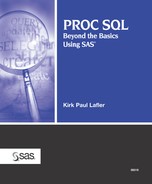1.4. Data Integrity
Webster’s New World Dictionary defines integrity as “the quality or state of being complete; perfect condition; reliable; soundness.” Data integrity is a critical element that every organization must promote and strive for. It is imperative that the data tables in a database environment be reliable, free of errors, and sound in every conceivable way. The existence of data errors, missing information, broken links, and other related problems in one or more tables can affect decision-making and information reporting activities resulting in a loss of confidence among users.
Applying a set of rules to the database structure and content can ensure the integrity of data resources. These rules consist of table and column constraints and will be discussed in detail in Chapter 5, “Creating, Populating, and Deleting Tables.”
1.4.1. Referential Integrity
Referential integrity refers to the way in which database tables handle update and delete requests. Database tables frequently have a primary key where one or more columns have a unique value by which rows in a table can be identified and selected. Other tables may have one or more columns called a foreign key that is used to connect to some other table through its value. Database designers frequently apply rules to database tables to control what happens when a primary key value changes and its effect on one or more foreign key values in other tables. These referential integrity rules restrict the data that may be updated or deleted in tables.
Referential integrity ensures that rows in one table have corresponding rows in another table. This prevents lost linkages between data elements in one table and those of another enabling the integrity of data to always be maintained. Using the 3NF tables defined earlier, a foreign key called CUSTNUM can be defined in the PURCHASES table that corresponds to the primary key CUSTNUM column in the CUSTOMERS table. Users are referred to Chapter 5, “Creating, Populating, and Deleting Tables,” for more details on assigning referential integrity constraints.
